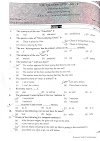Stationary wave
The waves formed when two waves having same amplitude and same frequency propagating in opposite direction superimpose.
Stationary waves are also known as standing waves.
Examples of Stationary wave:
Organ Pipes – Longitudinal stationary waves are formed.
Wave in stretched string – Transverse stationary waves are formed.
Do you know?
• At nodes
i. Strain, pressure, energy is maximum.
ii. Displacement, velocity is minimum.
• At antinodes
i. Displacement is maximum
ii. Pressure, energy,strain is minimum.
Distance between two adjacent nodes or antinodes is λ/2. And between consecutive nodes and antinodes is λ/4.
All particles between two adjacent nodes are in same phase and particles on two sides of a node are in opposite phase.
Waves in organ pipe
Longitudinal stationary waves are formed.
There are open organ pipe and closed organ pipe.
Expressions:
Figures:
Note: What is harmonics and overtones? Well, the integral multiples of fundamental frequency are known as harmonics and the higher nodes of vibration, whose frequencies are integral multiples of fundamental frequency, are known as overtones.
Wave in string
- Transverse stationary waves are formed.
Number of nodes = Number of antinodes + 1 = Number of modes of vibrations (harmonics) = Number of loops
harmonics have frequency:
Resonance Tube
Stationary longitudinal wave are produced.
It is used for measurement of velocity of sound.
Calculations:
.....i , e is end correction of pipe.
.....ii
Solving i and ii,
So,
Now, similarly, 3*i = ii
Solving;
End Correction
We know that due to inertia of air, antinode is formed slightly above the open end of pipe. The distance e of antinode from open end is called end correction.
According to Rayleigh, 𝑒 = 0.6 𝑟
End Correction in Open Pipe:
For harmonics:
(P = 1, 2, 3, .......n)
End Correction in closed pipe:
For harmonics:
(P = 1, 3, 5, .......n-1)









0 Comments